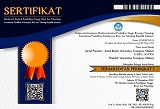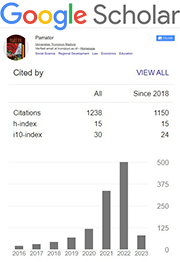Evaluasi Pasca Pembangunan Proyek Infra-struktur : Sebuah Kebutuhan Penguatan Kapasitas Birokrat Perencana di Pemerintah Daerah
Abstract
Infrastructure development in an area before construction requires preparation and comprehensive initial studies and is an obligation for infrastructure project owners. Likewise, infrastructure development work is completed and operated, post-development evaluation is still needed to avoid unexpected impacts from infrastructure development. It has not been taken into account in the feasibility study. The regions' readiness and role are expected because the areas where the infrastructure is located have an interest and are the areas that are directly affected. However, post-development evaluation of infrastructure is often not carried out properly due to the limited capacity of regional human resources, especially planning bureaucrats in planning infrastructure development and then carrying out post-development evaluations of the infrastructure in their area. Local governments need to initiate capacity building activities for planning bureaucrats and related agencies so that each bureaucrat has a systemic thinking foundation in his work. The second level, local governments cannot work alone to improve the quality of their human resources. Local governments need to greet the nearest tertiary institution with various expertise and contribute this expertise to planning bureaucrats and related technical agencies. Besides, the level II regional government also needs to collaborate with the central government to provide expert assistance regarding post-infrastructure development evaluation.
Keywords
Full Text:
PDF (Bahasa Indonesia)References
American Association of State Highway and Transportation Officials, (2009). Transportation and Sustainability Best Practice Background: Prepared by CH2M HILL and Good Company for Center for Environmental Excellence by AASHTO Transportation and Sustainability Peer Exchange May 27-29, 2009, Gallaudet University Kellog Center.
Blanchard, B., S., and Fabrycky W., J. (1998). System Engineering and Analysis. 3nd Ed. Prentice Hall International Inc. USA. ISBN 0-13-095062-9
Excel, Nicolas Jacob., Rietveld, Piet. (2010). Perception of Public Transport Travel Time and Their Effect On elatihan Choice-Set Among Car Drivers. Journal of Transport and Land Used.
Jackson, M. C., (2002). Systems Approaches to Management, Kluwer Academic Publishers, USA. eBook ISBN 0-306-47465-4.
Mingers, J. (2006). Realising Systems Thingkings: Knowledge and Action in Management Science. 2nd Ed. Springer Science+Business Media inc., USA.
Muhammadi, A.E.S.B., (2001). Systems Dynamic Analysis: Environmental, Social, Economic, Management. Jakarta: UMJ Press
Wang, J., Lu, H., & Peng, H. (2008). System dynamics model of urban transportation system and its application. Journal of Transportation Systems Engineering and Information Technology, 8(3), 83-89.
DOI: https://doi.org/10.21107/pamator.v14i1.9257
Refbacks
- There are currently no refbacks.
Copyright (c) 2021 Budisantoso Wirjodirdjo, Diesta Iva Maftuhah, Iffan Maflahah

This work is licensed under a Creative Commons Attribution-ShareAlike 4.0 International License.
Jurnal Pamator : Jurnal Ilmiah Universitas Trunojoyo by Universitas Trunojoyo Madura is licensed under a Creative Commons Attribution-ShareAlike 4.0 International License.















.png)